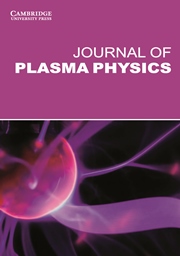No CrossRef data available.
Article contents
Quantized tensor networks for solving the Vlasov–Maxwell equations
Published online by Cambridge University Press: 18 September 2024
Abstract
The Vlasov–Maxwell equations provide an ab initio description of collisionless plasmas, but solving them is often impractical because of the wide range of spatial and temporal scales that must be resolved and the high dimensionality of the problem. In this work, we present a quantum-inspired semi-implicit Vlasov–Maxwell solver that uses the quantized tensor network (QTN) framework. With this QTN solver, the cost of grid-based numerical simulation of size $N$ is reduced from $O(N)$
is reduced from $O(N)$ to $O(\text {poly}(D))$
to $O(\text {poly}(D))$ , where $D$
, where $D$ is the ‘rank’ or ‘bond dimension’ of the QTN and is typically set to be much smaller than $N$
is the ‘rank’ or ‘bond dimension’ of the QTN and is typically set to be much smaller than $N$ . We find that for the five-dimensional test problems considered here, a modest $D=64$
. We find that for the five-dimensional test problems considered here, a modest $D=64$ appears to be sufficient for capturing the expected physics despite the simulations using a total of $N=2^{36}$
appears to be sufficient for capturing the expected physics despite the simulations using a total of $N=2^{36}$ grid points, which would require $D=2^{18}$
grid points, which would require $D=2^{18}$ for full-rank calculations. Additionally, we observe that a QTN time evolution scheme based on the Dirac–Frenkel variational principle allows one to use somewhat larger time steps than prescribed by the Courant–Friedrichs–Lewy constraint. As such, this work demonstrates that the QTN format is a promising means of approximately solving the Vlasov–Maxwell equations with significantly reduced cost.
for full-rank calculations. Additionally, we observe that a QTN time evolution scheme based on the Dirac–Frenkel variational principle allows one to use somewhat larger time steps than prescribed by the Courant–Friedrichs–Lewy constraint. As such, this work demonstrates that the QTN format is a promising means of approximately solving the Vlasov–Maxwell equations with significantly reduced cost.
Keywords
- Type
- Research Article
- Information
- Copyright
- Copyright © The Author(s), 2024. Published by Cambridge University Press



